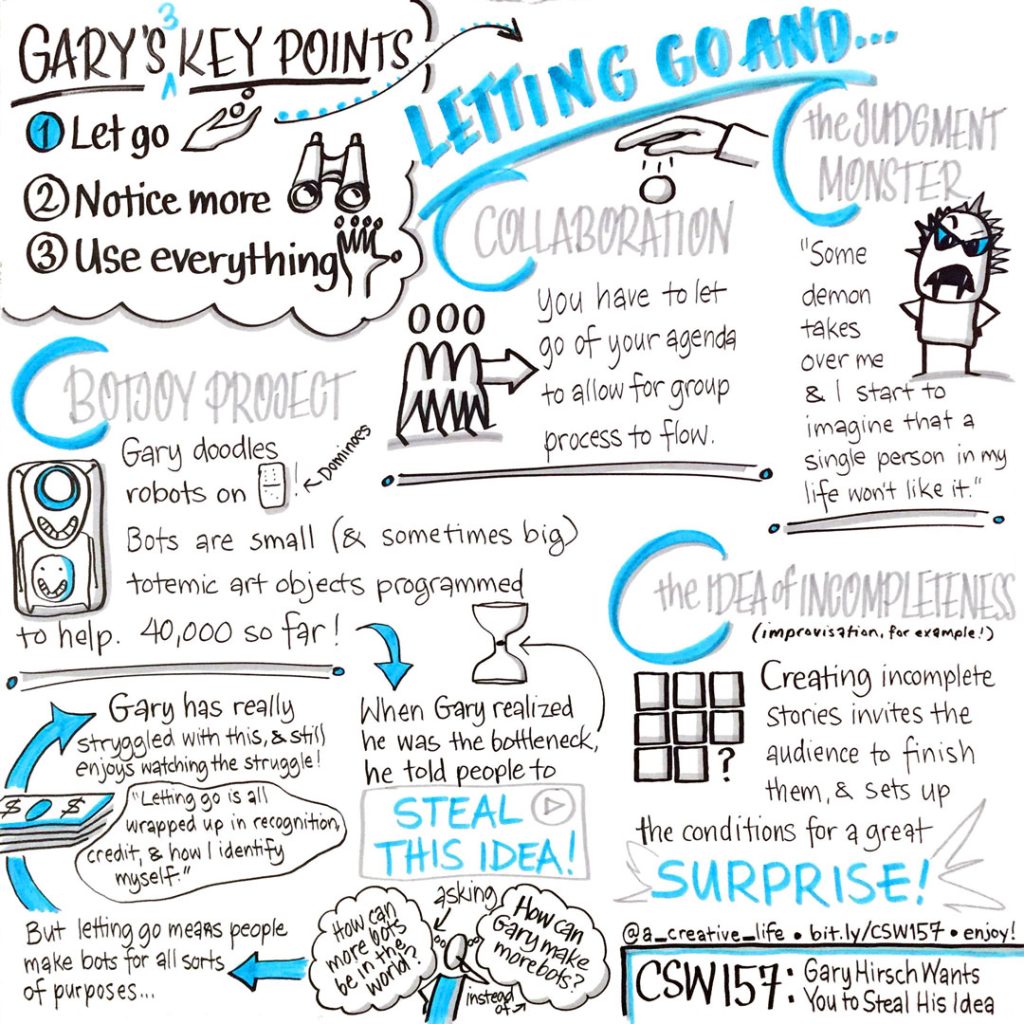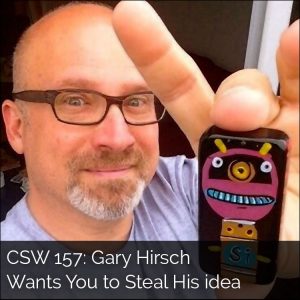
 I first encountered Gary Hirsch at the World Domination Summit in Portland, Oregon, where he improvised a rock band with 3,000 people.
I first encountered Gary Hirsch at the World Domination Summit in Portland, Oregon, where he improvised a rock band with 3,000 people.
I’m not kidding. He made a rock band with all 3,000 of us. (You’ll hear how he did this when you listen to the episode.)
This was an activity that Gary had originally developed for a TEDx talk. He was looking for something he could do with a live audience that would also be interesting when watched later, which would demonstrate his three points:
- Let go
- Notice more
- Use everything
Here’s how it works:
Gary asks people to look around the space and notice something they haven’t noticed before. Then they turn to someone next to them, and combine the things they noticed to come up with the name of a rock band (for example, Chandelier Exit).
Then, using “verbal chasing,” he asks questions to find out more things about the rock band.
For example, “This band reached its height of popularity in what year?”
“And the name of the platinum selling album was…?”
“And I understand the lead singer is in the audience tonight — where’s the lead singer?”
etc. (Listen to the episode to hear Gary describe it.)
Listen in as we talk about letting go; the “judgment monster”; the delight of creating incomplete works that invite others to finish them; improvisation; his Botjoy project; and more.
The Concept (and Challenge) of Letting Go
Letting go and collaboration:
We come to every creative process with a “shadow story” — what we want to have happen. This is important, because if you don’t let go of your agenda when you’re making something with someone else, you won’t progress and you can’t create flow.
Letting go and “the judgment monster”:
“Some demon takes over me, and I start to imagine that a single person in my life won’t like it… Making things can make you feel a bit crazy, no doubt.”
“Maybe one person’s crappy is another person’s snappy.”
The idea of incompleteness:
Creating incomplete stories that invite the audience to finish them. Gary gets off on (good) surprise, and letting go of an incomplete story sets up the conditions for that. Other people’s interpretations of his work often surprise him, and that delights him!
This place of being surprised is also the same place as Creative Sandbox Way™ Guidepost #6: Ask “What if..?” Which is also the place of improvisation.
Improvisation “is like magic to me,” says Gary.
Botjoy:
Gary doodles robots on the back of dominoes. These robots do different things — bravebots help you be brave, joybots give you random joy. The project has been a vehicle for collaboration and creating art that helps people, and has led to public art murals around the world.
When Gary realized that he was the bottleneck for making these robots, he let go and made it “open source,” inviting anyone to make bots and share them.
In other words, he decided to ask the question, “How can more bots be out in the world?” instead of, “How can Gary make more bots?” So he literally made a video telling people, “Steal This Idea.”
But letting go means that people make bots and use them for all sorts of purposes, including commercial ones!
Gary has really struggled with this, and he still does sometimes, but he also enjoys watching himself struggle with it.
“Letting go is all wrapped up in recognition, and it’s all wrapped up in credit, and it’s all wrapped up in how do I identify myself… there’s a lot going on. Anybody who makes things will appreciate that.”
On Your Feet and Applied Improvisation
Gary runs a consultancy called On Your Feet, which he got started through a T-shirt! He was selling hand-painted T-shirts on the street in Portland, when a guy named Robert Poynton bought a T-shirt and struck up a conversation with him. Robert asked Gary what else he did. “Well, I do improv,” said Gary.
“How does that work?” asked Robert.
“Well, anybody could do it,” said Gary.
“How about 90 ad executives in Arizona in 2 weeks?”
“Sure!” said Gary.
Two weeks later, Gary was co-leading an offsite retreat with Robert, and that was the beginning of On Your Feet.


